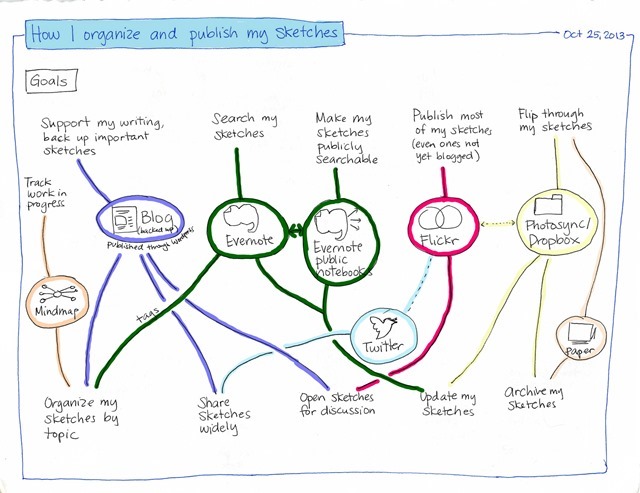How I organize and publish my sketches
Posted: - Modified: | blogging, drawing, organization, sketchesIn a recent blog post, Mel Chua wrote: “I’m still trying to figure out how to best store/catalogue my (growing) collection of sketches so it’s easy for people to access it.” So, here’s how I handle mine!
I have three types of sketches:
- A1. Public: Sketches I can publish (and usually that I want to write about someday)
- A2. Public, blogged: Sketches I have written about
- B. Private sketches to help me think
My goals are to:
- Support my writing: Blogging, naturally.
- Search my sketches: Evernote’s fantastic for this, since I can have my public and private sketches in one place
- Make my sketches publicly searchable: Evernote shared folders are great for that; Flickr and my blog are useful too. I often use Evernote to give someone a keyword search or tag search through my sketchnotes, sketchbook, or visual vocabulary. (Evernote users can join these notebooks and get updates automatically!)
- Publish most of my sketches: Blogging can take me a while, so I try to get public sketches out there as soon as possible so that they don’t get lost. Flickr and Evernote help.
- Flip through my sketches: Great for doing reviews and triggering memories. =) Can’t beat paging through local files manually or in a slideshow.
- Organize my sketches by topic: Evernote, Flickr, and my blog let me tag things with keywords, while a mindmap lets me give my sketches more structure.
- Share sketches widely: My blog and Twitter seem to be the best ways to do this, although Flickr is useful too.
- Open sketches for discussion: My blog is the best place for that, although Flickr and Twitter are handy as well.
- Update my sketches: Whether I’m colouring things in or checking off boxes, I want an easy way to get to a sketch and update it in Evernote and Flickr. If I’ve blogged about it, I’m okay with the blog post having the archived version of the image.
- Archive my sketches: I want to back up digital copies in several places so that I can recreate my collection if needed. Blogging, Flickr, Dropbox/file backups, PDF collections…
Stuff I’ve tried that didn’t work out so well:
- Referring to external services in my blog posts: Flickr? The Gallery2 instance I installed? Problematic if code changes, services go down, accounts are discontinued, or (in one annoying case) my self-hosted Gallery2 gets compromised. Disk space is cheap, so I just re-publish images using WordPress’ upload mechanisms (most blogging tools handle this automatically).
- Picking just one way to publish stuff: Flickr is better for volume and some discussion, Evernote is better for search, my blog is better for sharing and long-term search. Since no tool has everything I need, I’ll just have to put up with the hassle of replicating information.
- Just using automatic organization: For the last few years, I relied on Dropbox folders and Evernote items. Dropbox folders are fine for organizing by date and Evernote’s great for tags, but I want manual organization as well – organizing things by topics and subtopics, tracking things in progress, and so on. That’s why I’m experimenting with mindmaps now.
Stuff I’m working on next:
- Monthly and quarterly PDF packages of my sketches, organized by date or topic: for ease of printing and review
- Letting people know about available resources (my Flickr stream or Evernote notebooks) so that they can search/discuss/subscribe
See my drawing workflow for other notes about my process. Hope this helps!


2 comments
Dave P
2014-05-04T07:52:37ZI've been keeping a diary (handwritten, pen) for a few years and was faced with integrating photographs, sketches with the diary text.
Eventually I developed a method of integration / publishing.
1. Weekly read the handwritten notes into empty XML outline (any org type format would suffice). Save for access via main diary app (I use dropbox). I am happy with Dragon dictate - except it means I have to have a windows machine.
2. For images /sketches, read out the metadata - sufficient for search etc. Have available a list of keywords and try to keep to them.
3. Speech recognition is good enough to do the hard work, check in emacs for typo's (read'o's?) and correct.
4. When building the diary check that all images are available where expected, e.g.
source / metadata says file124.png - validation checks for that file, reports error when not there!
5. Indexing / toc created by integration software (docbook XML for me).
6. Table of figures maintained.
7. Metadata is searchable (grep worst case).
HTH
sachac
2014-05-06T00:15:55ZYeah, I find that speech recognition is a handy way to get text into my computer quickly and ergonomically (especially when copying quotes from books). Thanks for sharing your indexing system! =)